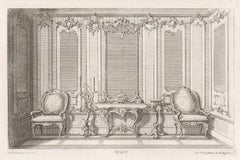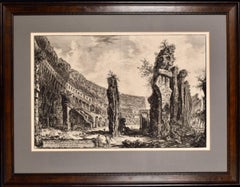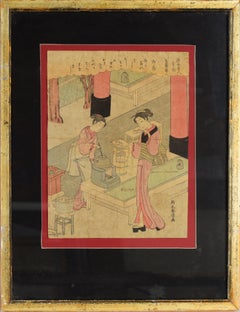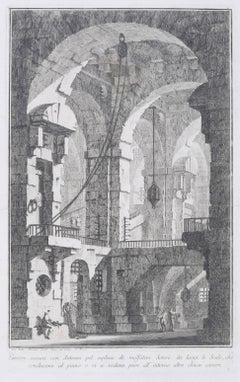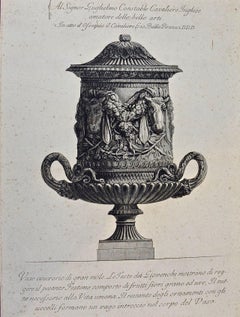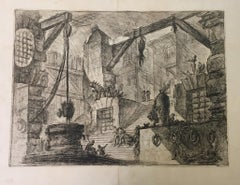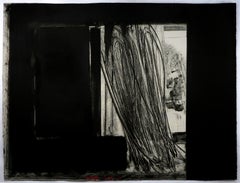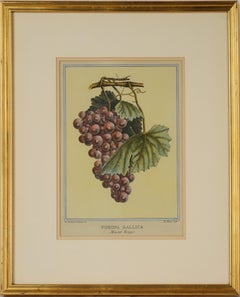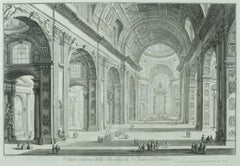Mid-18th Century Interior Prints
to
1
9
3
6
1
Overall Width
to
Overall Height
to
11
2
10
2
1
1
122
221
1,109
781
11
13
21
54
39
85
74
213
247
88
101
10
9
11
8
6
4
2
2
2
1
1
1
1
1
1
1
1
1
1
1
1
1
15
7
2
2
1
4
5
14
2
Period: Mid-18th Century
Rococo interior design and furniture, German mid 18th century etching
By Franz Xaver Habermann
Located in Melbourne, Victoria
Rococo interior design and furniture, etching, by Franz Xaver Habermann (1721-1796), circa 1750.
Lettered 'F. X. Haberman, inv. et del. loh. Georg Hertel, excud : Aug. Vind., number...
Category
Rococo Mid-18th Century Interior Prints
Materials
Engraving, Etching
The Roman Colosseum: A Framed 18th Century Etching of the Interior by Piranesi
Located in Alamo, CA
This large framed 18th century etching by Giovanni Battista Piranesi entitled "Veduta dell'interno dell'Anfiteatro Flavio detto il Colosseo" (View of the interior of the Flavian Amph...
Category
Old Masters Mid-18th Century Interior Prints
Materials
Etching
Deutzia Flowers: The Wife of Kasamori - Original Woodblock Print
Located in Soquel, CA
Deutzia Flowers: The Wife of Kasamori - Original Woodblock Print
Deutzia Flowers: The Wife of Kasamori, from the Series "Beauties of the Floating World Associated with Flowers" by S...
Category
Edo Mid-18th Century Interior Prints
Materials
Woodcut, Ink, Rice Paper
$720 Sale Price
20% Off
Carcere ascura
Located in Fairlawn, OH
Carcere ascura
Etching, 1743
Signed in the plate bottom left corner
From: Prima Parte, 1743
Second edition: 1750-1778
Watermark: R 37-39
A lifetime impression printed during Piranesi’s life, before the plates are moved to Paris by his sons in the 1790’s
This image foretells Piranesi's famous set, Carceri (Prisons) which is his next creative effort.
Condition: Horizontal crease midway in the sheet associated with the manufacture of the paper.
Visible watermark verso
Small printer crease in the bottom right below the caption plate.
Image size: 14 1/2 x 9 1/2 inches
Reference: Robison 3 iii/VI
Piranesi In Rome: Prima Parte di Architetture e Prospettive
"Although Piranesi studied architecture in Venice, he never was able to find work in the field other than a few jobs involving remodeling in Rome. While Piranesi was struggling to support his architectural endeavors upon his arrival in Rome in 1740, he spent a short period of time in the studio of master painter Giovanni Battista Tiepolo (1696-1770) in addition to his apprenticeship with Giuseppe Vasi. The first production of Piranesi’s early years in Rome and a culmination of his training under Vasi, Tiepolo, and his uncle, was the Prima Parte di Architetture e Prospettive (1743). The Prima Parte was a collection of twelve etchings of imaginary temples, palaces, ruins, and a prison. During this time, Piranesi was still developing the unique style of etching he is known for today, and as such the Prima Parte differs significantly in technique compared to later works. In the Frontispiece of the Prima Parte, Piranesi’s lines are definite and exact with very little flow to them, designed in the form of traditional etching. The detail is immaculate, and yet perspective of the piece is oddly simple and familiar to the viewer. Piranesi’s technique employs miniscule markings and lines, intricately woven together to create a stippling effect. The Prima Parte, described as “rigid” by art historian Jonathan Scott, came to be seen as a stark contrast to his later sketches, which were much lighter and freer. Influenced by the style of Tiepolo, which epitomized the lightness and brightness of the Rococo period, Piranesi adopted some of the more painterly techniques of the masters he apprenticed under. Piranesi made the medium of etching appear as though it was a sketch or a painting, hence a “freer” and more fluid design in his later works. For example, the frontispiece of the Prima Parte read as an etching to Piranesi’s audience, but in his later vedute, the style of etching almost appears to be made of brushstrokes. Moreover, at the same time Piranesi was working on the Prima Parte, he aided the artist Giambattista Nolli. There is a small section of Nolli’s map...
Category
Old Masters Mid-18th Century Interior Prints
Materials
Etching
Ancient Roman Marble Vase: 18th C. Piranesi Etching Vaso Cinerario di Gran Mole
Located in Alamo, CA
"Vaso Cinerario di Gran Mole. Le Teste dei Giovenchi mostrano di reggere it pesante Festone composto di Frutti Fiori Grans ed use. Il tuto Necefsario all Vita Umana. Il Restante degl...
Category
Old Masters Mid-18th Century Interior Prints
Materials
Etching
The Well, Carcere XIII - Etching by G.B.Piranesi - 1750s
Located in Roma, IT
Giovanni Battista Piranesi, The Well, Carcere XIII , from “ Images of Prisons”, Buchard , Rome, 1749-50
Etching on laid paper. Signed on plate “ Piranesi F.” lower-right. Very good ...
Category
Modern Mid-18th Century Interior Prints
Materials
Etching
Marquis de Marigny: An 18th C. Wille Engraved Portrait after a Tocque Painting
By Louis Tocqué
Located in Alamo, CA
This is a mid 18th century engraved portrait of Abel François Poisson de Vandières, Marquis de Marigny by Jean Georges Wille after a painting by Louis Tocque...
Category
Mid-18th Century Interior Prints
Materials
Engraving
S. Paolo Fuori Le Mura (Vedute della Basilica di S. Paolo fuor della mura)
Located in Fairlawn, OH
S. Paolo Fuori Le Mura (Vedute della Basilica di S. Paolo fuor della mura)
Etching, 1748
From: Vedute di Roma, Plate 8
An early Roman printing, published by Bouchard e Gravier
Watermark: Fleur de Lys in a double circle
Signed in the plate
Condition: Small margins as are common with Bouchard published impressions.
Centerfold (as usual)
Rich impression with good contrasts
Plate/Image size: 15 7/8 x 24 1/8 inches
Sheet size: 17 3/8 x 24 3/4 inches
Reference: Focillon 723
Wilton-Ely 138
Hind 6 ii/VI, Bouchard e Gravier printing, before the price and numbers in later states
This image is Piranesi’s second interior scene from the Vedute di Roma. The first interior is a less complex composition of the Interior of St. Peters which lacks the challenging perspective that the artist masters in this image.
The Papal Basilica of St. Paul Outside the Walls...
Category
Old Masters Mid-18th Century Interior Prints
Materials
Etching
Rococo design for a gate, German mid 18th century etching
Located in Melbourne, Victoria
Rococo design for a gate, etching, by Joseph Baumann (active 1740-1760), circa 1750.
Published by Martin Engelbrecht (1684–1756).
Similar works ar...
Category
Rococo Mid-18th Century Interior Prints
Materials
Engraving, Etching
18th Century Etching of Ancient Roman Architectural Objects by Giovanni Piranesi
Located in Alamo, CA
A. Tigna Protensa Super Media Epistylia, B. Praecisiones Tigorum Quaqua Versus Extrinsectus Apparentium, C. Opae Extremitates Tigorum Contintes, Fig. I, plate 88 from "Vasi, Candelab...
Category
Old Masters Mid-18th Century Interior Prints
Materials
Etching
Rococo design for a gate, German mid 18th century etching
Located in Melbourne, Victoria
Rococo design for a gate, etching, by Joseph Baumann (active 1740-1760), circa 1750.
Published by Martin Engelbrecht (1684–1756).
Similar works ar...
Category
Rococo Mid-18th Century Interior Prints
Materials
Engraving, Etching
La Messe (The Mass), after Caravaggio
Located in Middletown, NY
Chiaroscuro woodcut with underlying engraving on cream laid paper, printed from two blocks in brown and olive. 10 1/4 x 12 3/4 inches (260 x 321 mm) (plate), full margins with the text printing clearly below in black ink. In very good condition with scattered surface soiling and several minor flecks of light discoloration in the margins, especially in the area of the lower right corner, well outside of image area. Unobtrusive notations in pencil in the margin and on the verso. All condition issues are consistent with age. After a drawing of the same title by Polidoro da Caravaggio...
Category
Old Masters Mid-18th Century Interior Prints
Materials
Laid Paper, Engraving, Woodcut
William Hogarth's "Analysis of Beauty": A Set of Two Framed 18th C. Engravings
Located in Alamo, CA
The two plates in this set were created utilizing both engraving and etching techniques by William Hogarth in 1753, originally as illustrations of his book on aesthetics, entitled "Analysis of Beauty". Due to their popularity, these plates were later published separately. The publication line in the lower right reads: "Designed, Engraved, and Publish'd by Wm. Hogarth, March 5th 1753, according to Act of Parliament." Hogarth's original copper plates were refurbished where needed by James Heath and engravings were republished in London in 1822 by Braddock, Cradock & Joy. This was the last time Hogarth's copper plates were used for printing. Most were melted during World War I for the construction of bombs.
These large folio sized "Analysis of Beauty" engravings are presented in antiqued gold-colored frames with double mats; the outer silk mats are light brown-colored and the inner mats are dark brown. Each frame measures 27.38" x 31.25" x 1.13". There is one tiny spot in the right margin of plate 1 and another in the lower margin; the latter could be from the printing process. The prints are otherwise in excellent condition.
The "Analysis of Beauty" series is in the collection of many major museums, including: The British Museum, The Metropolitan Museum of Art, The Tate Museum, The Chicago Art Institute and The Fine Arts Museums of San Francisco.
The first engraving (Plate 1) depicts a courtyard of statues which is filled with some of the most famous works of classical sculpture. The most important sculptures are surrounded by less impressive works. The Medicean Venus (#13) is in the center with a statue of Julius Caesar (#19) to the right, elevated on a pulley with a short, overdressed Brutus stands over the falling Caesar. The Apollo Belvedere (#12) is next. A judge stands to the right with his foot on a cherub (#16). Another crying cherub holds a gallows and wipes his tears with the judge's robe.
A sphinx (#21) and the drunken Silenus (#107) are below the Venus. Michaelangelo's torso (#54) and a statue of Antonius (#6) are seen in the foreground. The Farnese Hercules (#3) and a bust of another Hercules (#4) under two statuettes of Isis are also included in the scene.
The key to these objects is included in the form of a serpentine line winding around a cone (#26), Hogarth's "Line of Beauty". For Hogarth the winding line is an essential element of beauty in art. Hogarth's theory of beauty is communicated in this plate.
Plate 2 is thought to represent the Wanstead Assembly, with the Earl of Tynley and his household. It is an adaptation of a scene in the Happy Marriage series, which complements Hogarth's Marriage à la Mode...
Category
Old Masters Mid-18th Century Interior Prints
Materials
Engraving, Etching
Elizabeth, Countess of Northumberland: Mezzotint After a Painting by J. Reynolds
By Joshua Reynolds
Located in Alamo, CA
This is an 18th century mezzotint portrait of Elizabeth, Countess of Northumberland, Baroness Percy by Richard Houston after a painting by Joshua Reynolds, published in London by Robert Sayer in 1763. It is a rare, full length portrait of Elizabeth, who was known as Lady Betty. Lady Betty stands, facing to the right, holding her coronet, and wearing her peeress’s ermine and velvet robes over a brocade dress. In the background are a column, a billowing drape, and the grounds of Alnwick Castle...
Category
Mid-18th Century Interior Prints
Materials
Mezzotint
The So-Called Tempio della Tosse, Near Tivoli. Interior Upright
Located in Fairlawn, OH
The So-Called Tempio della Tosse, Near Tivoli. Interior Upright (Veduta interna del Tempio della Tosse)
"Temple of the Cough"
Etching, 1764
Signed in the plate
From: Vedute di Roma...
Category
Old Masters Mid-18th Century Interior Prints
Materials
Etching
Frontispiece from "Carceri d'Invenzione" - Etching by G. B. Piranesi - 1749/59
Located in Roma, IT
Carcere d'Invenzione is an original Modern Artwork realized by Giovan Battista Piranesi (Mogliano Veneto, 1720 - Rome, 1778).
Original Etchin...
Category
Modern Mid-18th Century Interior Prints
Materials
Etching
The So-Called Tempio della Tosse, Near Tivoli. Interior Upright
Located in Fairlawn, OH
The So-Called Tempio della Tosse, Near Tivoli. Interior Upright (Veduta interna del Tempio della Tosse)
"Temple of the Cough"
Etching, 1764
Signed in the plate
From: Vedute di Roma...
Category
Old Masters Mid-18th Century Interior Prints
Materials
Etching
Ruine di Sepolcro antico
Located in Fairlawn, OH
Ruine di Sepolcro antico
Etching, 1743
Signed in the plate bottomleft in the caaption plate
From: Prima Parte, 1743
Second edition: 1750-1778
Watermark: R 37-39
A lifetime impression printed during Piranesi’s life, before the plates are moved to Paris by his sons in the 1790’s
Coniditon: Excellent/Very good
Image size: 14 5/8 x 9 3/4 inches
Reference: Robison 17 iii/V
Piranesi In Rome: Prima Parte di Architetture e Prospettive
"Although Piranesi studied architecture in Venice, he never was able to find work in the field other than a few jobs involving remodeling in Rome. While Piranesi was struggling to support his architectural endeavors upon his arrival in Rome in 1740, he spent a short period of time in the studio of master painter Giovanni Battista Tiepolo (1696-1770) in addition to his apprenticeship with Giuseppe Vasi. The first production of Piranesi’s early years in Rome and a culmination of his training under Vasi, Tiepolo, and his uncle, was the Prima Parte di Architetture e Prospettive (1743). The Prima Parte was a collection of twelve etchings of imaginary temples, palaces, ruins, and a prison. During this time, Piranesi was still developing the unique style of etching he is known for today, and as such the Prima Parte differs significantly in technique compared to later works. In the Frontispiece of the Prima Parte, Piranesi’s lines are definite and exact with very little flow to them, designed in the form of traditional etching. The detail is immaculate, and yet perspective of the piece is oddly simple and familiar to the viewer. Piranesi’s technique employs miniscule markings and lines, intricately woven together to create a stippling effect. The Prima Parte, described as “rigid” by art historian Jonathan Scott, came to be seen as a stark contrast to his later sketches, which were much lighter and freer. Influenced by the style of Tiepolo, which epitomized the lightness and brightness of the Rococo period, Piranesi adopted some of the more painterly techniques of the masters he apprenticed under. Piranesi made the medium of etching appear as though it was a sketch or a painting, hence a “freer” and more fluid design in his later works. For example, the frontispiece of the Prima Parte read as an etching to Piranesi’s audience, but in his later vedute, the style of etching almost appears to be made of brushstrokes. Moreover, at the same time Piranesi was working on the Prima Parte, he aided the artist Giambattista Nolli. There is a small section of Nolli’s map...
Category
Old Masters Mid-18th Century Interior Prints
Materials
Etching
Camera sepolcrale
Located in Fairlawn, OH
Camera sepolcrale
Etching 1743
Signed in the bottom left corner
From: Prima Parte, 1743
Second edition: 1750-1778
Watermark: R 37-39
A lifetime impression printed during Piranesi’s life, before the plates are moved to Paris by his sons in the 1790’s
Condition: Excellent
Image size: 14 5/8 x 9 3/4 inches
Reference: Robison 20 iii/V
Piranesi In Rome: Prima Parte di Architetture e Prospettive
"Although Piranesi studied architecture in Venice, he never was able to find work in the field other than a few jobs involving remodeling in Rome. While Piranesi was struggling to support his architectural endeavors upon his arrival in Rome in 1740, he spent a short period of time in the studio of master painter Giovanni Battista Tiepolo (1696-1770) in addition to his apprenticeship with Giuseppe Vasi. The first production of Piranesi’s early years in Rome and a culmination of his training under Vasi, Tiepolo, and his uncle, was the Prima Parte di Architetture e Prospettive (1743). The Prima Parte was a collection of twelve etchings of imaginary temples, palaces, ruins, and a prison. During this time, Piranesi was still developing the unique style of etching he is known for today, and as such the Prima Parte differs significantly in technique compared to later works. In the Frontispiece of the Prima Parte, Piranesi’s lines are definite and exact with very little flow to them, designed in the form of traditional etching. The detail is immaculate, and yet perspective of the piece is oddly simple and familiar to the viewer. Piranesi’s technique employs miniscule markings and lines, intricately woven together to create a stippling effect. The Prima Parte, described as “rigid” by art historian Jonathan Scott, came to be seen as a stark contrast to his later sketches, which were much lighter and freer. Influenced by the style of Tiepolo, which epitomized the lightness and brightness of the Rococo period, Piranesi adopted some of the more painterly techniques of the masters he apprenticed under. Piranesi made the medium of etching appear as though it was a sketch or a painting, hence a “freer” and more fluid design in his later works. For example, the frontispiece of the Prima Parte read as an etching to Piranesi’s audience, but in his later vedute, the style of etching almost appears to be made of brushstrokes. Moreover, at the same time Piranesi was working on the Prima Parte, he aided the artist Giambattista Nolli. There is a small section of Nolli’s map...
Category
Old Masters Mid-18th Century Interior Prints
Materials
Etching
Related Items
Howard Hodgkin hand-colored Early Evening in the Museum of Modern Art
Located in New York, NY
Large scale black and white abstract interior scene with dots, lines, brushstrokes, and hand painting in grey, to hang in contemporary, modern and minimalist spaces. While British pop artists such as David Hockney and Patrick Caulfield numbered amongst Howard Hodgkin's circle of friends, Hodgkin's work is painterly, emotional, expressionist, and abstract.
Early Evening in the Museum of Modern Art, by Howard Hodgkin. Signed by the artist, numbered, and dated 79 lower center in red crayon. Soft-ground etching printed from the same plate as 'Late Afternoon in the Museum of Modern Art', with hand coloring in black gouache on Grey BFK Rives mould-made paper.
This print depicts an abstracted scene, perhaps a sculpture in front of a window in the Museum of Modern Art, Oxford, in Hodgkin's signature painterly style. The expressive mark-making in this print is an example of the artist’s movement in the late 70s towards pronounced gestures. Wide areas of deep black pigment contrast urgent swipes of ink. Always seeking greater richness in his prints, Hodgkin layered ink and hand coloring in this print, rendering each impression in the edition unique.
Part of a series of four prints reflecting on a visit to...
Category
Abstract Mid-18th Century Interior Prints
Materials
Gouache, Etching
$2,250
H 29.5 in W 38.75 in
Bow Street Office: Rowlandson Hand-colored Engraving from Microcosm of London
Located in Alamo, CA
An early 19th century print entitled "Bow Street Office", an illustration (Plate 11) from "The Microcosm of London", published in London in 1808 by R. Acker...
Category
Other Art Style Mid-18th Century Interior Prints
Materials
Aquatint, Etching
Thomas RowlandsonBow Street Office: Rowlandson Hand-colored Engraving from Microcosm of London, 1808
$655
H 18.5 in W 20 in D 0.88 in
Inside the castle by David Hockney (Six Fairy Tales from the Brothers Grimm)
Located in New York, NY
From David Hockney’s celebrated Six Fairy Tales from the Brothers Grimm portfolio, an image of the story ‘The boy who left home to learn fear’. Hockney chose this story for its obscu...
Category
Modern Mid-18th Century Interior Prints
Materials
Etching, Aquatint
$2,250
H 17.75 in W 16 in
'Jesus and the Woman at the Well, ' by Amand-Durand, Engraving
By Armand Durand
Located in Oklahoma City, OK
This early 19th century framed 35" x 31" engraving by artist Amand-Durand depcits an etching of 'Jesus and the Woman at the Well,' after the Dutch master, Rembrandt van Rijn. This poignant Biblical story is depicted by Arman-Durand in Rembrandt style...
Category
Old Masters Mid-18th Century Interior Prints
Materials
Engraving
$1,200 Sale Price
20% Off
H 30.5 in W 26.5 in D 1.5 in
Original AJANTA INDIA Bodhisattva Padmapani vintage travel poster 1959
Located in Spokane, WA
Original Ajanta India vintage travel poster from 1959. Archival linen backed in Grade A condition, ready to frame. Note that a later edition of this poster was printed but the im...
Category
Old Masters Mid-18th Century Interior Prints
Materials
Lithograph
$995
H 39.5 in W 24.25 in D 0.3 in
William P. Hicks, Circus
Located in New York, NY
William P. Hicks has drawn everything about the circus that will fit in the plate. The main figure is an aerial act with a woman balancing on rope held by a figure on the floor. Ther...
Category
American Modern Mid-18th Century Interior Prints
Materials
Etching
Sportsmen
Located in Storrs, CT
Sportsmen. 1908. Etching and drypoint. Exsteens 271.i/ii. 11 1/4 x 5 3/4 (sheet 17 3/8 x 12 1/4). Series: Les Bars. From the first state edition of 30 proofs with the remarque sketch...
Category
Post-Impressionist Mid-18th Century Interior Prints
Materials
Drypoint, Etching
THE WAGON SHOP
Located in Santa Monica, CA
GUSTAVE BAUMANN (1881 – 1971)
THE WAGON SHOP, 1910 (Chamberlain 24)
Color woodcut signed in pencil. Unnumbed from an edition 100 as published in the Hills o’ Brown...
Category
Modern Mid-18th Century Interior Prints
Materials
Woodcut
Church of St. Costanza, Rome: An 18th Century Piranesi Architectural Etching
Located in Alamo, CA
This is a framed 18th century Giovanni Battista Piranesi etching entitled: "Veduta interna del Sepocro di Santa Costanza, fabbricat...
Category
Old Masters Mid-18th Century Interior Prints
Materials
Etching
$3,775
H 27 in W 32 in D 1.5 in
Portrait of Albert Schweitzer.
Located in Storrs, CT
Portrait of Albert Schweitzer. Etching. 11 3/4 x 9 3/4 (sheet 16 1/4 x 14). Illustrated: Beall, American Prints in the Library of Congress, page 205....
Category
American Modern Mid-18th Century Interior Prints
Materials
Etching, Drypoint
$750 Sale Price
50% Off
H 11.75 in W 9.75 in D 0.5 in
The Lonely House at Asajigahara.
Located in Middletown, NY
A scene from a series of ghost stories and spooky rural legends.
Tokyo: Matsuki Heikichi, 1896.
Woodcut in ink with embossing and hand-coloring in watercolor on handmade mulberry pa...
Category
Edo Mid-18th Century Interior Prints
Materials
Watercolor, Handmade Paper, Woodcut
Jewish Shtetl Shabbat Candles Russian Judaica Etching w Hand Watercolor Painting
Located in Surfside, FL
EUGENE ABESHAUS Leningrad, Russia, (1939-2008)
Hand-Colored, with watercolor painting, Etching hand signed in pencil in English and Hebrew
Numbered 47/110
Framed 21.5 x 16. image 13.5 x 9
Eugene Abeshaus (also spelled Evgeny Abezgauz, Евгений Абезгауз in Russian; 1939–2008) was a Jewish artist who worked in Russia (then USSR) and Israel.
Born in Leningrad to a typical intelligentsia family, Abeshaus was educated as an electrical engineer but soon abandoned this career and enrolled in the Mukhina School for Applied Art. By the time of his graduation from the famous “Mukha” (Fly in Russian), he had already developed a critical stance towards the official Soviet art dominated by the Communist ideology and began exhibiting at semi-underground exhibitions. This was culminated by his taking part in a famous 1975 exhibition at the Nevsky Palace of Culture. Abeshaus was fired from his job and censured by the official press – which however admitted his "artistic taste, a good sense of color and form".
Soon afterwards, Abeshaus set up, together with several Jewish artists, the Alef Group and became its leader. The group’s first exhibition in November 1975 was held at Abeshauses’ small apartment. According to the Alef Manifesto written by Alek Rapoport, “We are trying to conquer the influence of small-town Jewish art and find sources for our work in deeper, wiser, and more spiritual European culture, and from it build a bridge to today and tomorrow". He was part of a generation of Russian, mostly Jewish artist's that included Oskar Rabin, Evgeny Rukhin...
Category
Modern Mid-18th Century Interior Prints
Materials
Watercolor, Etching, Paper
Previously Available Items
Pomona Gallica, Muscat Rouge - Botanical Grape Print
Located in Soquel, CA
Pomona Gallica, Muscat Rouge - Botanical Grape Print
Botanical Print depicting a grape vine by Henri-Louis Duhamel du Monceau (French, 1700-1782). Red grapes hang from a vine, in fr...
Category
Impressionist Mid-18th Century Interior Prints
Materials
Ink, Paper
H 24.75 in W 20.5 in D 1 in
St. Peter's Interior with the Nave
Located in Fairlawn, OH
St. Peter's Interior with the Nave
Veduta interna della Basilica di S. Pietro in Vaticano
Etching, 1748
Signed in the plate
From: Vedute di Roma, Plate 5
An early Roman...
Category
Old Masters Mid-18th Century Interior Prints
Materials
Etching
The Sawhorse
Located in New York, NY
A superb, dark, richly-inked impression of this etching, engraving and open-bite. Fourth state (of 6); Robison's second edition, second through third issues, printed from the early 1...
Category
Italian School Mid-18th Century Interior Prints
Materials
Engraving, Etching
"Principal Inhabitants of the Moon": A Framed 18th Century Satire by Hogarth
Located in Alamo, CA
This is a framed original satirical etching/engraving by William Hogarth, entitled "Some Principal Inhabitants of ye Moon: Royalty, Episcopacy and Law", originally published in London in 1760.The inscription reads: ""Some of the principal inhabitants of [the] moon as they were perfectly discover'd by a telescope brought to [the] greatest perfection since [the] last eclipse; exactly engraved from the objects whereby [the] curious may guess at their religion, manners, &c.". Although this may be an original life-time printing, it may have been published by Baldwin Craddock and Joy in London in 1822 from Hogarth's original copper plate that was reworked where needed by Heath, referred to as the Heath edition. This publication was the last time that Hogarth's plates were used for a printing. Most were subsequently destroyed and those remaining are primarily held by institutions.
The scene is presented within a circle, as if seen through a telescope viewing the moon, surrounded by a square border, under which is engraved the title. The figures, who are satirically supposed to be the inhabitants of the moon, sit on a wooden platform suspended above the clouds. Three seated figures are supposed to represent the "Monarchy, Episcopacy, and Law". "Monarchy", representing royalty, sits on a throne wears a crown and he holds a globe and a sceptre. His face is a gold coin. The symbol of perpetuity, is embroidered on the cloth under his throne.
"Episcopacy", representing the church, is operating a pump by pulling on a bell-rope fastened around a bible attached to the pump handle. The pump pours out money into a chest representing the church coffers and wealth. The chest is decorated with an armorial escutcheon, containing a knife and fork, topped by a church leader's mitre. Episcopacy's face is a Jew’s Harp and his right foot rests on a pile of three cushions. A cloven foot is seen protruding from under his religious robe.
"Law" wears the type of wig worn by 18th century English judges. He holds a large sword on the right, but he does not appear to have a left arm. His face is a hammer resembling that of the Viking god Thor. Behind him a dagger appears to be thrust through the bottom of a sieve.
The bodies of the attendants on Monarchy are composed of circular fire-screens, resembling shields. The trunks of the Courtiers are large looking-glasses, the sconces, with candles in them serving for hands and arms. The face of the chief of these is the reverse of a sixpence; and a key significantly appended to his sash at once denotes his sex and office. Under the figure of Law are a male and female modishly dressed. Her head is a tea-pot, her neck is a drinking-glass and her body is a half open fan. The male figure's face is a coat of arms and his legs are fan sticks. He appears to be courting the female.
There is a great deal of satirical symbolism in this print and their meaning is not always obvious. Hogarth may have planned to include an explanation since there are letters a, b, c, d, e, f and g placed over or under some of the figures and objects. The reference books by Ronald Paulson, such as "Hogarth's Graphic Works, provide some possible interpretations.
The print is presented in an ornate glossy black wood frame with beaded gold-colored outer and inner trim, a beaded gold-colored fillet and a cream-colored silk mat. There is a small defect in the frame's right upper edge. The print was not examined out of the frame, but the visible portions of the print are in excellent condition. The frame and mat style are identical to another old master print listed on 1stdibs, a 17th century portrait of the old master artist Petrus de Jode by Anthony van Dyck. This print can be viewed by placing the 1stdibs reference # LU117327129592 in the search field. These two framed prints would make a striking display grouping. A discount is available for purchase of the pair.
Artist: William Hogarth (1697-1764) was an English painter, printmaker, pictorial satirist, social critic, and editorial cartoonist. Hogarth's work was extremely diverse, ranging from serious realistic paintings and portraits to satire and moralistic pieces filled with symbolism. He often communicated his moral message in a series of paintings and engravings, such as: A Rake's Progress, Marriage A...
Category
Old Masters Mid-18th Century Interior Prints
Materials
Engraving, Etching
H 22 in W 19 in D 1.13 in
The Philosophe en Meditation
Located in San Francisco, CA
This artwork titled "Le Philosophe en Meditation" 1753 is an engraving after Rembrandt Harmensz Van Rijn 1606-1669. The plate was engraved by Pierre Lo...
Category
Realist Mid-18th Century Interior Prints
Materials
Engraving
Hand Colored Vue d'optique of the Hotel des Invalides Dining Room in Paris
Located in Alamo, CA
A hand colored vue d'optique or perspective view engraving of the interior of the Hotel des Invalides in Paris entitled "Vue Perspective du Refectoire de L'Hotel Royal des Invallides a Paris". It depicts the refectory or dining room of the Hotel Royal des Invalides in Paris, where a large group of men, possibly clerics, academics or convalescing soldiers are eating. They are dressed in colorful red, grey, blue and yellow coats. The Hotel Royal des Invalides is a complex of buildings in the 7th arrondissement of Paris, France, containing museums and monuments dedicated to the military history of France, as well as the Saint-Louis des Invalides cathedral. It also houses a hospital and a retirement home for war veterans. It is one of the most important masterpieces of classical French architecture.
Jacques...
Category
Other Art Style Mid-18th Century Interior Prints
Materials
Engraving
H 19.75 in W 23.5 in D 0.88 in
Pair of Piranesi Etchings of Ancient Roman Architectural Objects, 18th Century
Located in Alamo, CA
A pair of etchings created by Giovanni Piranesi depicting Roman architectural details from his "Le Antichità Romane" (Ancient Rome) published in 1756. The first print is entitled "Pr...
Category
Old Masters Mid-18th Century Interior Prints
Materials
Etching
French Commode Table Etching From "The Gentleman and Cabinet-Maker's Director"
By Thomas Chippendale
Located in Houston, TX
Engraving from a book titled, "The Gentleman and Cabinet-Maker's Director" printed in 1753. Thomas Chippendale was the designer and Mary and Matthew Darly...
Category
Rococo Mid-18th Century Interior Prints
Materials
Etching
H 16.5 in W 22.5 in D 0.75 in
Spaccato Interno della Basilica di S. Paolo fuori della Mura” Etching,
Located in San Francisco, CA
This mid-18th century etching by Giovanni Battista (Giambattista) Piranesi (b. 1720-1778) is titled “Spaccato Interno della Basilica di S. Paolo fuori della Mura” (“Cutaway view of the Interior of the Basilica of San Paolo fuori delle Mura”. It is from his most important and famous series, “Vedute di Roma” , the artist’s historically important series of 135 etchings documenting views of ancient and then-contemporary Rome, published from 1745 onward. This work was first published in 1749. This is the 3rd state of 7 published states. In the Hind reference, this is Hind 7/iii. This particular etching is on a thick laid paper with the watermark of a fleurs de lys enclosed by two circles, with a smaller circle above in which is an indistinguishable letter, perhaps a B. This etching is in good condition and a nice crisp image because it is an early state. It is not trimmed, framed, mounted or laid down. There is a ¼” tear along the lower edge. There are a number of slightly thinned areas along all edges, but because the print is on such a thick laid paper, there is very good density and integrity even in the slightly thinned areas on the edges. The center crease, present in all of the Vedute di Roma works is almost invisible; one must look very closely at the horizontal rafters on the top of the print to almost make out the crease. The print measures 16 1/2 x 24 1/8 in. (sheet 18 ¾” in x 26 1/2 in.)
The interior of the basilica of Saint Paul outside the walls shows its frescoes, papal portraits, and imperial Roman marble...
Category
Realist Mid-18th Century Interior Prints
Materials
Etching
H 18.5 in W 26.75 in D 0.1 in
Interior view of the Church of San Stefano Rotondo
Located in New York, NY
Giovanni Battista Piranesi (1720-1778), Veduta dell’interno del Tempio di S. Stefano Rotondo (Interior view of the Church of San Stefano Rotondo), etching, 1756. First Edition, from the series Le Antichita Romane, Bouchard e Gravier 1756, section XXV, figure 2 [signed, numbered and titled in the plate]. References: Focillon 192, Wilton-Ely 327. In good condition, with margins, 5 1/2 x 8, the sheet 6 1/4 x 9 inches.
A very good impression, printed on a stiff cream laid paper.
Piranesi developed the plates of the Antichita Romane (Roman Antiquities) after eight...
Category
Old Masters Mid-18th Century Interior Prints
Materials
Etching
The Sleeping Congregation.
Located in Storrs, CT
1736 (Heath Edition 1822). Etching and engraving. Paulson 140 iv/iv; British Museum Satires 2285. 10 1/2 x 8 3/16 (sheet: 12 7/8 x 9 3/4). Inscription: in plate below image, lower le...
Category
Old Masters Mid-18th Century Interior Prints
Materials
Engraving, Etching
Recently Viewed
View AllMore Ways To Browse
Herbert Gentry
Hermes Bag Painting
Highwaymen Art
Hildegard Hamilton
Hispano Suiza
Hollywood Hills Painting
Honey Kurlander
Honore Sharrer
Horatio Mcculloch
Howard Barron
Howard Rogers
Huge Mythological Painting
Hungarian Jewish Paintings
Hunt Horse And Hounds
Hunt Slonem Cardinal
Hunt Slonem Lories
Hyam Hyams
Ian Houston
